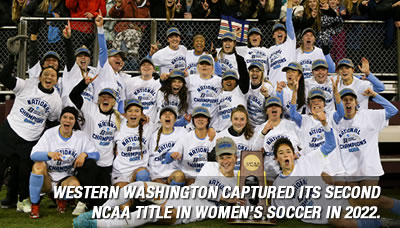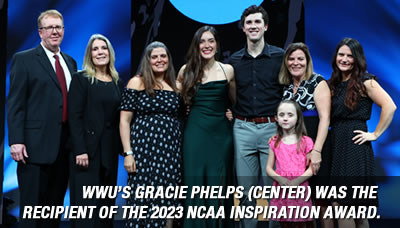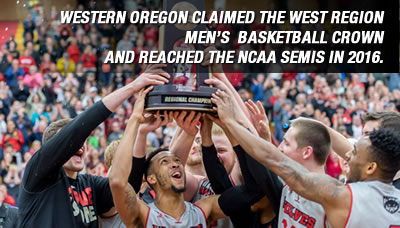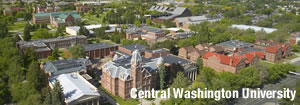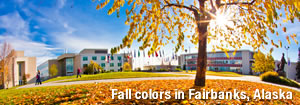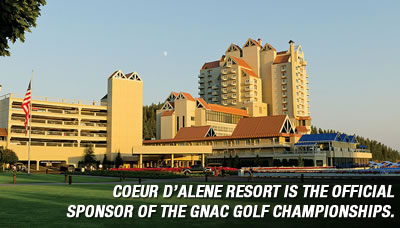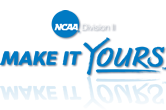Friday, June 26, 2015
By Evan O'Kelly
MSUB Director of Athletic Communications
After more than 35 years as a sports information director – including serving as the only SID in the history of the GNAC – Bob Guptill retires after the 2014-15 year.
BILLINGS, Mont. – Throughout its 15-year history, the Great Northwest Athletic Conference has served tens of thousands of student-athletes, representing the premier venue of competition at the NCAA Division II level in the Pacific Northwest.
Since its inaugural season in 2001-02 when its only championships were cross country and outdoor track and field, it has expanded tremendously as it now presents 13 championships. With Concordia University being the latest addition as a full-time member, it serves as a reminder that the GNAC continues to grow and change each year.
Student-athletes, coaches, and staff from the conference’s 11 member schools have come and gone throughout the years, contributing their respective portions to the GNAC’s history. The physical location of the conference office has even changed, moving from Spokane, Wash., to Portland, Ore., in 2012.
But from Day 1, there has been a single constant. One man who has been there for every pitch, tipoff, starting gun and whistle, and whose work has been unparalleled throughout the GNAC’s history and over the past four decades overall.
After announcing his retirement from his position as information director for the GNAC earlier this spring, Bob Guptill hasn’t had much time to consider what his next step will be.
“I have been doing the same thing for 35 years, so it is definitely going to be different,” Guptill said. “I am definitely going to miss coming into work every day, but I haven’t thought about what I’ll be doing.”
Guptill isn’t sure how he will fill his summer months, which have been reserved for updating record books and building schedules two or three years in advance.
Perhaps before he shuts his door at the conference office one final time, he will turn his attention to the bookcase on his left. Its brown shelves sag bearing the weight of numerous black binders, all of which are stuffed to capacity. The progressive yellowing of the pages down the rows gives away that they are organized by year, each perfectly in its place.
What has become an encyclopedia is the entire history of the GNAC, each and every page compiled by Guptill. Every putout made on the diamond and javelin thrown on the infield is tucked away on that shelf, permanently stored in one of the most magnificent record databases in the history of college sports.
Guptill alone is responsible for the thoroughness and complexity of the records, and their accuracy and extensiveness are a testament to his work as an SID. For Guptill, they are the final chapter in a book he started authoring when he began taking statistics for the Colfax High School baseball team in 1967.
From there, he has gone on to contribute more information to the world of college sports than most ever have, his work spanning three different centuries and holding responsibility for records compiled that date back to the late 1890s.
It is a contribution that will live on for centuries to come.
CALL TO A LEGEND
When Guptill began his freshman year at Colfax High in Washington, John Huber held play-by-play responsibility for the Bulldogs’ athletic teams. “Bob came to me and asked if he could provide stats for me on the broadcasts,” Huber remembered. “Consequentially, he started doing stats on the radio with me, and he ended up working with me for all four years. The stats he gave me were always facts, and he and I got along great.”
Guptill had a knack for math, and a gift for calculating percentages in his head. He quickly found those skills translated well into the world of sports, leaving an impression on Huber that ultimately put him on track for his career to come.
As Guptill completed his prep years and elected to attend Washington State University, Huber recognized that Guptill’s skills with statistics were too rare to pass up.
“I gave his name to Dick Fry, who was the sports information director at WSU at the time,” Huber recalled. “I told him, ‘here’s a guy who, if you want stats and facts, he is going to get them for you.’”
Fry is a legendary figure in the world of Cougar Athletics, a World War II veteran who served as sports information director at WSU from 1957-70. He received the tip on Guptill at the tail end of his tenure in athletics, but during the brief time they spent together Fry could tell immediately that he had a bright young star on his hands.
“I worked closely with Bob in the SID office there, and he was doing a lot of research on the records for football, basketball, and baseball starting from Year 1,” said Fry. “It was a project I had started, and that he picked up and finished.”
Naturally gravitating towards a seemingly impossible task, Guptill tracked down newspapers recorded on microfilm from as far back as 1892 as he was determined to create a comprehensive history of Cougar Athletics.
“He stayed up late at night and worked on weekends looking through that microfilm,” Fry said. “Not only was the print bad, but some of the reproduction was really hazy. He spent hour after hour running through those things. It was a Herculean task, believe me.”
Fry witnessed Guptill’s dedication to the monotonous task, but was unaware at the time the impact that the research would ultimately have on a project of his own. In 1989, Fry penned the historical book, The Crimson & the Gray: One Hundred Years with the WSU Cougars, as part of the university’s athletic department centennial celebration.
“Practically all of the statistics for that book from Ground Zero up until the 1970s, Bob provided,” Fry said. “He had everything: Football, basketball, and baseball from Year 1. I couldn’t have written that book without Bob’s material.”
FROM THE COUGS TO THE ‘CATS
What Guptill accomplished in his four years as a student at WSU was unprecedented in the world of sports information. Never before had Mike Wilson, who was Fry’s successor as SID and Guptill’s main guide, seen an individual so consumed in and passionate about his work.
“He was just a good, solid, hard worker, and what he did was done well,” Wilson said. “He may have been the first student from WSU who Bobo Brayton took on road trips, because he proved that he deserved to go with the team.”
Brayton, who wound up with 1,162 wins in his career as head baseball coach of the Cougars, identified the value Guptill provided and deemed him a vital part of WSU’s baseball team. “Anything that team needed him to do, Bob jumped right in there and was more than happy to do it,” Wilson said.
Ready to hit the ground running after completing his degree at WSU, Guptill was hired as the sports editor at the Dalles Chronicle (Ore.). He held that position for the next four years before relocating to Ellensburg, Wash., and taking on the same job at the Ellensburg Daily Record for one year in 1979.
Guptill’s early contributions while working in sports information proved to be too invaluable for him to stray from the industry, as an opening for SID at Central Washington University beckoned him in 1980. For the next 20 years, Guptill set a new standard for covering Wildcat Athletics, becoming a fixture in small college athletics in the northwest.
“What I enjoyed most about my time at Central was the opportunity to work with a lot of great coaches and people,” Guptill said. “Dean Nicholson was the basketball coach there my first 10 years, and he along with his father are the winningest coaches in the history of collegiate basketball with 1,114 wins.”
Today, the Wildcats’ Nicholson Pavilion is the home court for basketball and volleyball, the floor named after the historic figures in CWU Athletics. Guptill is quick to point out that their combined win total is a question in the board game Trivial Pursuit, one of a myriad of facts that has its place at the top of Guptill’s head.
“I have determined that 99.9 percent of the time, you can call and ask Bob a question, and he will know the answer from memory,” said Rob Lowery, longtime radio voice of Wildcat Athletics. “It could be any question going back to the beginning of the GNAC, his time at Central or at the PacWest, and he can pull the nugget of information. It is absolutely phenomenal.”
Lowery first crossed paths with Guptill when he began broadcasting CWU games for KXLE radio in Ellensburg in 1985, where he was quickly embraced by the latter as he entered a new professional setting. “I knew immediately that Bob was a tremendous resource for me coming into a situation where I would need a lot of background and prep for games,” Lowery said. “I didn’t know enough about Central at the time to do a good job, and he was invaluable right out of the gate.”
Thirty years later, the two have become the closest of friends and have continued to work together through the 2014-15 academic year. “For the last 30 years, Rob has handled the play-by-play for Central and we have had a long relationship,” Guptill said. “He has done a tremendous job for them and he is someone I feel fortunate to have worked with.”
“Bob is a person of absolute top quality in every regard; as a friend, as a colleague, and as a person,” Lowery said. “There is no finer person I have had the pleasure of knowing in my working life, and it is hard for me to put into words how highly I hold him.”
CHANGING TIMES
“I was one of the quickest folders ever. Once you got it into the envelope, we had a machine that could at least seal it, but you had to do it quickly and have it to the mailing room by noon on Monday.” – Paul Madison on the weekly routine of distributing press releases to the local media.
On the heels of Guptill’s retirement announcement, perhaps the only other person whose tenure in the industry dates back as far also announced that he was moving on. Paul Madison, who has spent the last 47 years overall and last 40 as sports information director at Western Washington University, has been one of the few constants throughout Guptill’s working career.
“I have worked with Paul since I got to Central, so he and I have had a working relationship for about 35 years,” Guptill said. “He is the cornerstone of sports information, and when you’re at one school for close to 50 years you’re someone who has been influential on a lot of people, including me. He is certainly someone I’ve enjoyed working with for the past three-plus decades.”
Through this year, Guptill received Madison’s GNAC Player of the Week nominations for WWU via email at the end of each week. Both men are quick to remember a time when it took much more than the click of a button to complete what is now an instantaneous task.
“After a basketball doubleheader, you’d have to call every newspaper separately, and dictate the box scores and a couple of highlights,” Madison recalled of his early days as an SID which began while he was a student at WWU in 1966. “We were talking with a real person at the Associated Press after every game, which was nice. We could actually make relationships and get a dialogue going.”
All news and information at the time was quite literally printed into press, and mailed out as a responsibility of the SID.
“You would write your release for the week, make a photo copy, and stick it into the envelope to mail out,” Guptill remembered. “Because of the time it took to get to the people who we were targeting, everything had to be done on Monday so it would arrive by Wednesday or Thursday.”
Four decades later, in a world where Twitter develops news virtually in real time to a global audience, Guptill and Madison are two of the pioneers who have transcended the various innovations in the communication industry.
“We didn’t have cell phones, by the way, so you had to find a phone booth to report the game if you were on the road with a team,” said Madison, who also spent time as a conference information director. “You would get home around six or seven Sunday morning after traveling all night, and by nine or ten people would start calling the conference office for updated statistics.”
As technology began revolutionizing standard operations for SIDs across the nation, word of mouth of Guptill’s and Madison’s accomplishments spread far enough to grab attention on a national stage. In 1993, Madison earned the Clarence “Ike” Pearson Award as the top sports information director in the National Association of Intercollegiate Athletics. Three years later, Guptill received the same honor before being inducted into the CWU Hall of Fame in 2001. Madison has since been elected to the College Sports Information Directors of America (CoSIDA) Hall of Fame.
A LIFE’S WORK
“There are not many people who are legendary in the sports information field. There are a lot who are good, some who are great, and then, frankly, there’s Bob.” – Rob Lowery on Bob Guptill.
From the Crimson and the Gray to the Wildcats of CWU to the GNAC, one constant throughout Guptill’s career has been the quality and dedication to his work. Some have witnessed Guptill’s work through various perspectives, including current CWU baseball coach Desi Storey and CWU men’s basketball coach Greg Sparling, who were each student-athletes at Central while Bob was the SID.
“Initially as a player, I didn’t realize that Bob was covering all of the sports here,” Storey said. “As a coach, it was great having him there because he was always on top of everything. He helped me in terms of scheduling as well as learning new rules.”
“Bob has done a tremendous job, not just during his time as the only sports information director the GNAC has ever known, but in his previous stops at Central Washington and the PacWest Conference,” said GNAC commissioner Dave Haglund. “He has always taken great pride in delivering timely and accurate information on behalf of the student-athletes, coaches, administrators and fans he served. He truly is a living history book of the GNAC and small-college athletics in the Pacific Northwest, and his work will live on for generations to come.”
As Guptill puts the finishing touches on his historic career, what stands out the most will be what he has built from the ground up with the GNAC. After helping establish the athletics record books at WSU and CWU, Guptill had an opportunity to start at Square 1 with the GNAC and create a living history in real time.“It was pretty much the opposite of what I did with my research before, because I had basically gone back 70-80 years in the history of those schools,” Guptill said. “The fact that (the GNAC) was a brand new conference meant we could create the statistical history from the very beginning.”
Guptill will miss the challenge of creating schedules with the GNAC’s unique travel, staying up late on Saturdays to receive results from basketball games in Alaska, and of course the daily Subway sandwiches for lunch. What he treasures most, however, are the relationships he has built with colleagues and having had the opportunity to serve the entire industry.
“The main thing I have always thought is that providing information to all of the SIDs in the conference was essential, and that was my main goal,” Guptill said. “I wanted to do everything that I could possibly do to assist SIDs in the coverage of their teams. That’s why I have always thought keeping accurate and historical information was so important. Hopefully I’ve accomplished that.”





